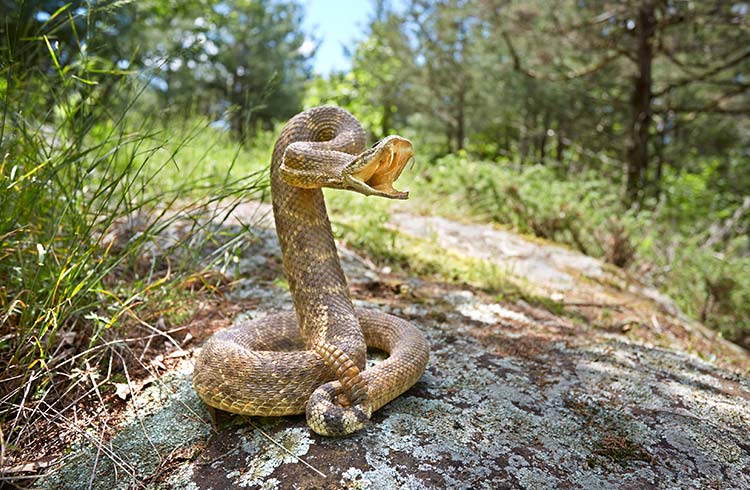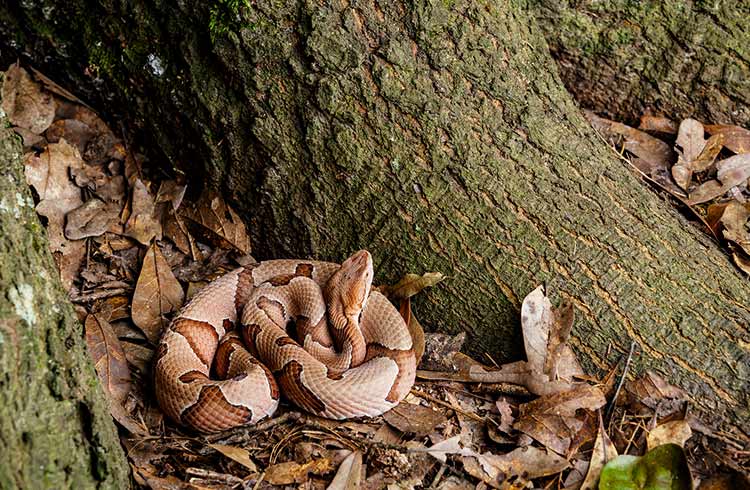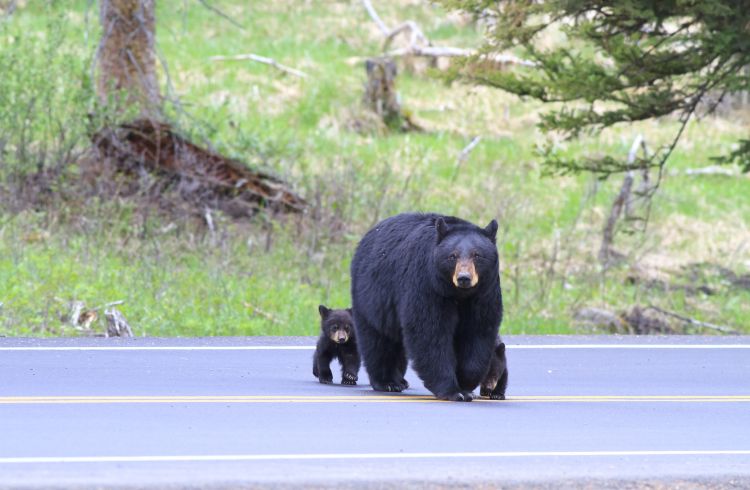Venomous Snakes in the USA: How to Treat a Snake Bite
Would you know what to do in the event of a snake bite? We asked Johnathan David from Everything Reptiles to share his tips on snake bite prevention and treatment, plus common snake locations in the United States.
 Photo © Getty Images/Tee-roy
Photo © Getty Images/Tee-roy
As an avid hiker and camper, I spend as much time as I can in nature during the spring, summer, and fall. One thing I have learned is that if you spend enough time outdoors, you are bound to encounter a variety of wildlife, including snakes.
This fact shouldn’t deter anyone from exploring the outdoors, but it does mean that if you plan to be active outside, you should be prepared for all situations. I’ll share my tips on what to do if you see a snake, and (although we all hope it doesn’t come to this) what to do if you get bitten.
Before you set off, these are some of the most common venomous snakes you should be aware of in the United States and where you’re likely to find them.
- Venomous snakes in the USA
- Common areas to find venomous snakes in the USA
- Snake bite prevention
- What to do if you are bitten by a snake
- Snake bite treatment
Venomous snakes in the USA
Most venomous snakes in USA are members of the pit viper family. Here are some of the most common kinds of vipers, as well as one other dangerous species.
Copperheads
- These snakes are easily identified by their reddish-brown heads and hourglass-shaped markings along their bodies
- They have blocky, triangular heads which are set off from their thick bodies by slender necks
- Baby copperheads have neon yellow tail tips, which they wiggle to lure prey. Their tails fade usually by the time they are three to four years old.
Cottonmouths (water moccasins)
- Like all vipers, cottonmouths have heat-sensing pits in their faces, between their eyes and nostrils, so that they can detect prey even when it’s dark
- Their bodies are thick and dark brown to black in color, with slightly paler bellies
- Cottonmouths are often confused with non-venomous water snakes. A sure way to tell them apart is by their eyes: cottonmouths and other pit vipers have slitted, cat-like pupils.
Rattlesnakes
- There are a number of subspecies of rattlesnake to be aware of, including timber rattlesnakes, eastern and western diamondback rattlesnakes, black diamond rattlesnakes, and tiger rattlesnakes
- Each species is distinct and differ in region, appearance, and toxicity of venom
- However, all rattlesnakes can be distinguished by the rattle on the ends of their tails, which they shake when they feel threatened, or as a warning before they attack.
Coral snakes
- Coral snakes are the only species in this list that are not members of the pit viper family. They are relatively slender snakes with bright red, yellow, and black stripes
- Coral snakes look very similar to harmless scarlet snakes. You can tell them apart by observing the order of their colors—coral snakes’ red stripes are bordered by yellow. As the saying goes: “red touching yellow kills a fellow; red touching black, safe for Jack.”
- Their range extends through the Southeast and along the Gulf of Mexico. You are less likely to come across one than you are the other snakes listed above, because they spend the majority of their time underground, only surfacing to hunt lizards, frogs, and other smaller snakes.
This list of venomous snakes is not completely comprehensive and only includes the most common snakes for the USA. Before taking a hiking or camping trip, be sure to research what kinds of wildlife you should watch out for.
Common areas to find venomous snakes in the USA
The kind of snakes you are likely to encounter depends which part of the country you are in, and the habitat and behaviors of the specific species.
- Copperheads and cottonmouths are most common across the East Coast and Midwest United States. Copperheads can be found in almost any habitat—including suburban backyards—whereas cottonmouths are semi-aquatic, and as such are almost always found in or near a body of water
- Those living in or visiting the South, Southwest, and Midwest should primarily be concerned with rattlesnakes. Texas and Arizona are the two states with the highest populations of rattlesnakes.

Snake bite prevention
Knowing where to look out for snakes is an important part of snake bite prevention.
- Snakes like to slither in tall grasses and brush. When hiking, always stay on marked trails and avoid walking in areas where you can’t see where you’re stepping
- If you do have to walk through tall grass, you should tread heavily and stamp your feet, as the vibrations on the ground will warn snakes that a large creature is nearby, and they should move away
- However, If you see a snake close to you, do not stamp your feet as this may cause the snake to feel threatened, and provoke it to bite. Stay still and wait for it to move away?
- Wearing tall boots and long pants can help protect your feet and ankles from a bite if you do step on or near a snake
- It is common for snakes to hide under logs, rocks, and even camping gear. Always use caution when picking up anything from the ground
- Never attempt to pick up a snake, even if you think it is dead. Do not seek them out, and if you happen to come across one, do not attempt to catch, trap, or kill it. Snakes will bite humans when they are threatened or feel as though they are being attacked. They do not bite randomly or without a reason. Leaving snakes alone is the best way to protect both yourself and the wildlife
- Most snake bites are to hands, feet, and ankles, and happen when people step on or pick up a snake.
What to do if you are bitten by a snake
If you do get bitten by a snake, don’t panic.
- Deaths from snake bites are extremely rare. Of the roughly 7,000 to 8,000 people who are bitten by snakes every year in the United States, only about five of these are fatal. As long as you receive proper and timely medical treatment for the bite, you do not have to worry about permanent damage or death
- Many snake bites (even those from venomous snakes) are dry, which means that no venom is released during the bite. You should always seek professional care for a snake bite (even if it is a dry bite, as there is always risk of infection,) but remember that you may not have even been envenomed (poisoned)
- Remain calm and still – keeping your heart rate down will slow the spread of the venom. Take deep breaths and move slowly or not at all if possible, while someone else goes for helps. If you are in a dangerous area or on a trail inaccessible to medical help slowly walk, not run, to a safe area, sit down and wait for help to arrive.
- The reason that the annual number of deaths from snake bites is so low is because of modern medicine. It’s important not to be hysterical, but also to treat a snake bite as a medical emergency. Even if you believe the bite was given by a non-venomous snake, the consequences of being wrong are too severe to merit the risk.
If you are able, try to identify the snake.
- It’s helpful if you are able to recognize the kind of snake that bit you or even remember distinctive patterns, colors, and size; these details can help medical professionals treat the bite
- However, do not risk going near the snake in order to make the identification
- Never attempt to trap, injure, or kill the snake that bit you.
Snake bite treatment
You should always carry a basic first aid kit when you are camping or hiking outdoors. While you are waiting for the professionals, you can begin treatment by doing the following:
- Disinfect the wound and cover it with a clean, dry bandage
- Remove any tight jewelry near the wound that could restrict blood flow if the area around the bite starts to swell
- Sit or lay down with the bitten limb below the level of the heart.
Never attempt to suck or cut out the venom from a snake bite. Venom spreads too quickly from the puncture site for either of these strategies to be effective, and either would only increase risk of infection to the wound.
If your bite is on an extremity, do not attempt to tourniquet the bitten limb. Doing so will cut off circulation and can make the injury worse by keeping the venom localized, leading to, at worst, death of the limb and amputation.
If you know you will be hiking in an area with venomous snakes, carry a compression bandage with you. In the event of a bite, wrap compression bandages up the length of the bitten limb. It should be tight enough to immobilize the limb, but not too tight that it cuts off blood flow. if you don’t have a compression bandage, you can improvise with a scarf, shirt sleeve, or other long, clean article of clothing.
Do not drink alcohol or caffeine. Caffeine will increase your heart rate, which you want to remain as low as possible. And while it might seem like a good idea to use alcohol as a painkiller, because it is a stimulant, it will first increase circulation (quickening the spread of venom) and as a depressant, weaken the body’s resistance.
Remember: the only effective treatment for a venomous snake bite is antivenom.
While coming across a venomous snake can be a frightening experience, don’t let fear keep you indoors this summer. Remember that most snakes you will encounter are harmless to humans, and even the venomous kinds will not attack unprovoked.
By taking appropriate precautions and knowing what to do in case of an emergency, you can ensure that you are as safe as possible when enjoying the outdoors.
Related articles
Simple and flexible travel insurance
You can buy at home or while traveling, and claim online from anywhere in the world. With 150+ adventure activities covered and 24/7 emergency assistance.
Get a quote

No Comments